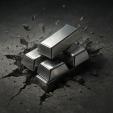Gold loses its safe-haven allure as U.S. Q2 GDP increases 3%
NEW YORK (July 30) A solid recovery in the U.S. economy during the second quarter is easing recession fears, which is taking a toll on gold market demand as its role as a safe-haven asset diminishes.
The advance reading of second-quarter U.S. Gross Domestic Product showed the economy grew significantly between April and June, rising 3.0%. This gain fully offset the 0.5% decline reported at the start of the year.
The data significantly exceeded expectations, as economists had forecast a 2.5% increase.
“The increase in real GDP in the second quarter primarily reflected a decrease in imports—which are subtracted in the calculation of GDP—and an increase in consumer spending. These movements were partly offset by decreases in investment and exports,” the report said.
Although gold continues to find support above $3,300 an ounce, the strong economic data pushed prices to session lows. Spot gold last traded at $3,320.90 an ounce, roughly unchanged on the day.
While GDP growth beat expectations, some analysts note that the figures continue to be influenced by trade volatility resulting from President Donald Trump’s trade war. The report highlighted a decline in imports between April and June.
“Overall, the report paints a picture of an economy benefiting from temporary trade dynamics rather than broad-based domestic strength heading into the second half of the year,” said Greg Michalowski, currency analyst at Forexlive.com.
In addition to stronger-than-expected growth, the report also revealed mixed inflation data.
The GDP Price Index rose 2.0% in the second quarter, down from 3.8% in the first quarter. Economists had expected a 2.2% increase.
Meanwhile, the core Personal Consumption Expenditures (PCE) Index rose 2.5%, up from 2.3% reported in the first three months of the year.
Jeffrey Roach, Chief Economist for LPL Financial, noted that although the economy improved in the second quarter, he doesn’t see sustainable momentum.
“Momentum is slowing. Real final sales to private domestic purchasers—the sum of consumer spending and gross private fixed investment—increased 1.2% in Q2, compared with an increase of 1.9% in Q1,” he said in a note. “Investors should focus on the deceleration in consumer spending. Now that delinquencies are starting to rise among upper-income consumers, we expect consumer spending to moderate further in the coming quarters. The Fed will likely be in a good position to cut rates by its September meeting. We should expect Chairman Powell and other committee members to prepare investors for a September cut.”
KitcoNews









